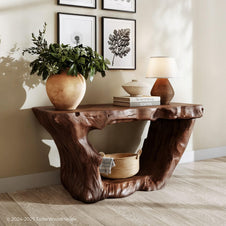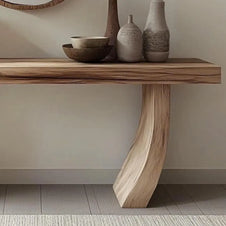Can floating shelves hold a lot of weight? This is a common concern for homeowners who want both style and function. Weight capacity depends on material, brackets, and installation quality. By understanding these factors, you can safely display books, décor, and even heavy items while maintaining a sleek look.
Understanding Floating Shelf Weight Capacity
If you are considering installing floating shelves, one of the first questions that comes to mind is: can floating shelves hold a lot of weight? This concern is especially common for homeowners who want shelves that are not only stylish but also practical. The truth is, floating shelves can be surprisingly strong, but their weight capacity varies widely depending on several critical factors.
At its core, the weight a floating shelf can hold depends on three things: the shelf material, the type of hidden bracket used, and the wall construction. A thick piece of hardwood mounted with steel rods into a solid wall will always outperform a thin MDF shelf hung with basic drywall anchors. This means that even two shelves of the same size can have very different capacities based on how they’re built and installed.
What Determines How Much Weight a Shelf Can Hold?
One of the most common questions homeowners ask is: what really decides how strong a floating shelf is, and can floating shelves hold a lot of weight? The answer comes down to a few key elements that work together to determine shelf capacity.
1. Material strength
The material is the foundation of any shelf. Solid woods like oak, walnut, or maple naturally support heavier loads because of their density and durability. In contrast, cheaper materials such as particleboard or MDF are more prone to sagging or even breaking under pressure.
If you’re planning to display heavy items like books or kitchenware, investing in solid wood is the best way to ensure strength.
For a sleek and timeless option, Walnut Floating Wall Shelves are a great pick. Built from rich walnut slabs, they’re not only elegant but also durable enough to handle everyday essentials.
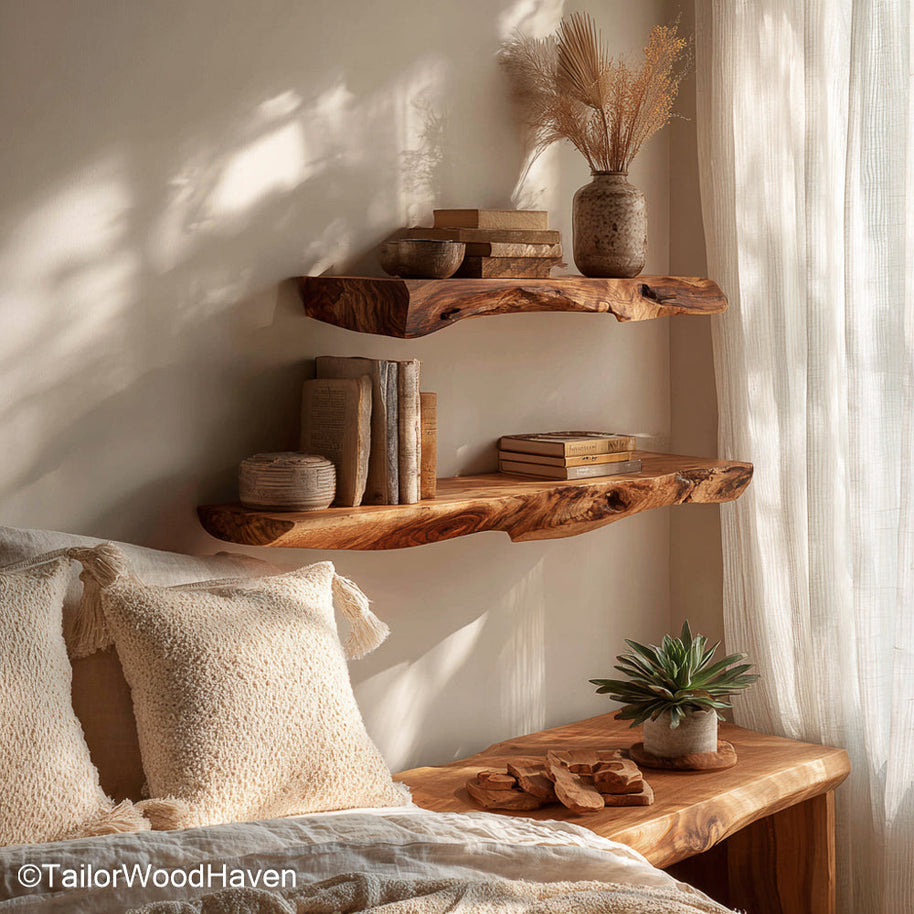
2. Bracket system
The hidden support brackets are just as important as the shelf itself. High-quality steel brackets distribute weight evenly across the wall, which allows your shelf to handle more than just decorative accents.
On the other hand, small or poorly designed hardware can limit how much you store and may even fail over time. If you’re asking yourself, can floating shelves hold a lot of weight in practical use, the bracket system is often the deciding factor.
3. Wall type
Finally, the type of wall you’re mounting into makes a huge difference. Anchoring shelves into studs or solid masonry drastically increases their weight capacity compared to drywall-only installations.
Even the strongest wood and brackets won’t perform well if the wall behind them can’t carry the load.
Together, these three elements-material, bracket system, and wall type-define whether your floating shelf will act as a purely decorative piece or a reliable storage solution. By choosing wisely, you’ll not only maximize safety but also extend the shelf’s lifespan.
Key Factors That Affect Strength
The question can floating shelves hold a lot of weight becomes clearer when you break down the specific factors involved.
Shelf Material (Wood, MDF, Metal, Glass)
The material of the shelf makes a huge difference. Solid hardwoods like walnut, oak, or maple provide excellent durability and can hold heavier loads without sagging.
In fact, if you love a rustic yet sturdy option, Handcrafted Floating Shelves in Live Edge Design are a perfect example - they combine natural beauty with strong performance.
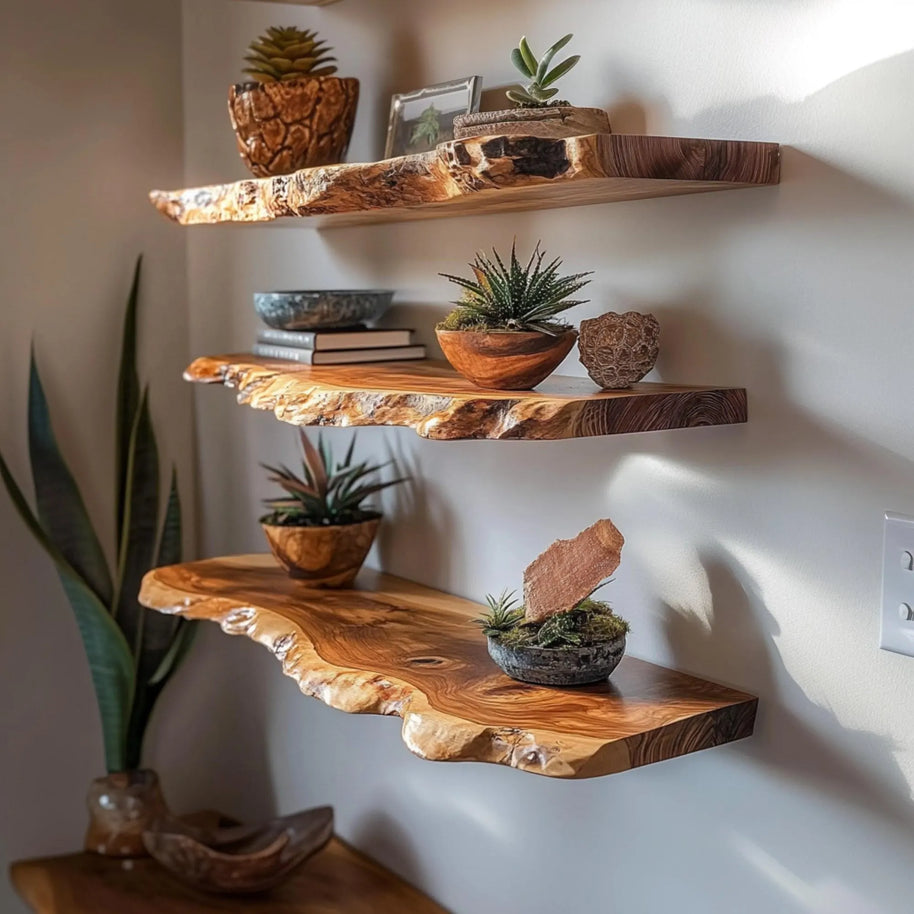
In contrast, MDF and particleboard are less dense, making them more prone to warping when overloaded. Metal shelves are very strong but may not fit all design aesthetics, while glass looks elegant but should only be used for lightweight items. When you’re wondering can floating shelves hold a lot of weight, the material choice should be your starting point.
Brackets and Hidden Support Systems
The invisible support system makes floating shelves so appealing. Strong steel rods anchored into wall studs provide stability, while weaker or improperly fitted brackets can lead to sagging. The depth of the shelf also plays a role - deeper shelves require stronger brackets.
Installation Methods and Wall Type
Even the strongest materials and brackets won’t matter if the shelf is installed incorrectly. Mounting directly into drywall without hitting studs will significantly limit weight capacity. In contrast, anchoring shelves into studs or masonry allows them to hold much more.
For detailed guidance on matching brackets to wall types, Shelfology’s Ultimate Guide to Floating Shelves is an excellent resource that breaks down installation best practices. If you’ve ever doubted can floating shelves hold a lot of weight, remember that installation is just as important as materials and hardware.
Testing & Ensuring Durability
Before you trust your shelves with valuable items, it’s smart to check how much weight they can handle. Many homeowners ask themselves: can floating shelves hold a lot of weight without bending or detaching? The best way to find out is through gradual testing.
How to Test Shelf Weight Capacity at Home
Start with lightweight objects like frames or small plants, then slowly add heavier items such as books or kitchen essentials. This step-by-step approach helps you see how the shelf reacts to pressure. If it begins to sag or shift, you’ll know you’re reaching its limit.
If your taste leans toward rustic charm, Live Edge Floating Shelves add a natural character to any wall while providing reliable strength. When properly mounted, they’re an ideal answer to the question: can floating shelves hold a lot of weight in areas like the living room or hallway.
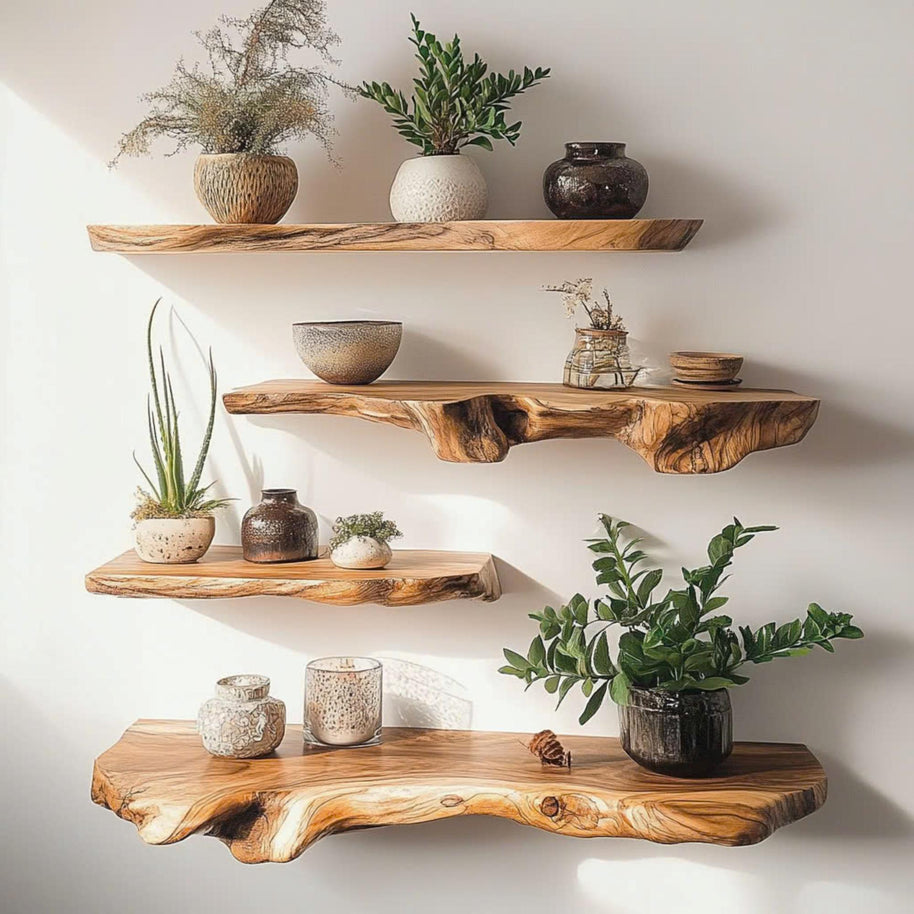
Common Mistakes That Weaken Floating Shelves
A frequent issue is overestimating shelf strength. Even strong shelves can fail if mounted incorrectly or overloaded. Another mistake is using poor-quality screws and anchors that can’t properly support the shelf.
This leads many people to ask again: can floating shelves hold a lot of weight over the long term? The answer depends on avoiding these pitfalls and making sure your shelves are installed with care.
By testing gradually and steering clear of common mistakes, you’ll gain confidence in your shelves and keep them safe for daily use.
Choosing the Right Floating Shelf for Your Need
When it comes to picking the right floating shelf, it’s important to think about both style and strength. Many customers often ask: can floating shelves hold a lot of weight if used daily in kitchens, bedrooms, or even workspaces. The good news is, with the right choice of material and installation, the answer is yes.
For eco-style interiors or playful designs, the Set of Tree Branch Floating Shelves makes a bold statement. While visually unique, these shelves are still practical and can hold lightweight décor, small books, or plants with ease.

At the end of the day, the right floating shelf depends on your needs. If you’re still wondering can floating shelves hold a lot of weight in your space, remember: choosing high-quality solid wood paired with proper installation is the best way to guarantee strength and longevity.
Expert Tips for Maximizing Shelf Strength
So, can floating shelves hold a lot of weight safely in the long run? The answer is yes - but only if you follow the right installation practices and maintain them properly over time.
Best Installation Practices
The foundation of strength lies in how the shelf is mounted. Always secure brackets directly into wall studs or solid masonry, never just drywall. Use heavy-duty steel brackets that are designed to distribute weight evenly across the shelf.
For homeowners asking can floating shelves hold a lot of weight when used in kitchens or offices, this step is crucial. Even the strongest wood won’t perform well if the support system is weak.
-
Double-check measurements to ensure brackets are level.
-
Avoid spacing brackets too far apart, especially on wider shelves.
-
Choose thicker boards for added durability.
These small adjustments make a big difference in shelf capacity and prevent accidents later.
Maintenance and Safety Checks
Even after installation, floating shelves need attention. Over time, screws can loosen or walls may shift slightly. Performing a quick check every few months ensures stability. Tighten screws, look for sagging boards, and redistribute weight if needed.
Regular maintenance answers the common question: can floating shelves hold a lot of weight over many years? With proper care, the answer is a confident yes. Not only will this protect your items, but it will also extend the lifespan of your shelves.
FAQs
1. How much weight can floating shelves realistically hold?
Most floating shelves can support 15–50 pounds, depending on material, bracket strength, and installation quality. With heavy-duty brackets secured into studs, some shelves can hold 100 pounds or more.
2. Can floating shelves hold heavy items like books or cookware?
Yes, but only if they’re made from durable hardwood and mounted properly into wall studs. For example, walnut or live edge wood shelves paired with strong brackets can safely carry heavy books or kitchenware.
3. What’s the best way to make floating shelves hold more weight?
To maximize capacity, always install brackets directly into wall studs, use thicker solid wood boards, and choose heavy-duty steel support rods. Regularly checking and tightening screws will also extend durability.
Final Thoughts
So, can floating shelves hold a lot of weight? Absolutely - but only if you choose the right materials, use strong hidden brackets, and install them securely into studs or solid walls. From heavy book collections to everyday kitchenware, floating shelves can support your lifestyle while keeping your home stylish and clutter-free.
By selecting durable options like walnut or live edge shelves and following proper installation methods, you’ll enjoy shelves that look amazing and work hard for years. Always remember: the key to strength isn’t just in the shelf itself but in how it’s installed.




